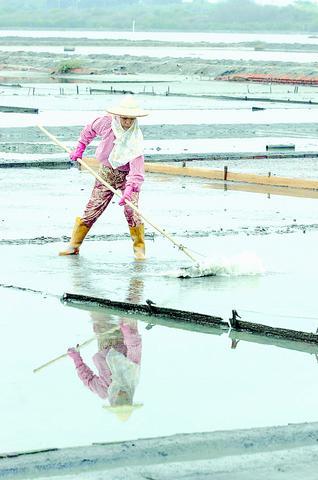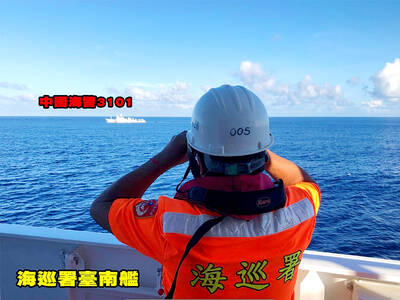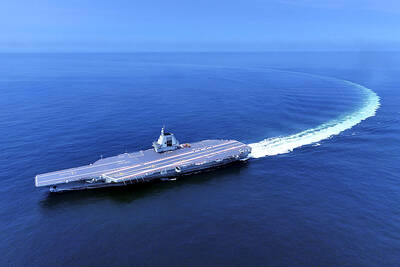The vast fields and adjoining buildings were once the center of one of Taiwan's most important industries -- making salt. With the decline of the industry they were left derelict, subject to the ravages of time and weather.
But now, with support from the Tainan City Government and the national Council for Cultural Affairs the plantation will be restored as the Salt Field Ecology and Cultural Village as part of a plan to revitalizing both the industry and the city.

PHOTO: CHIANG YING-YING, TAIPEI TIMES
The salt fields in Tainan span the old port areas between An-nan (

PHOTO: CHIANG YING-YING, TAIPEI TIMES
The salt-field operations started in 1919 during the Japanese occupation of Taiwan. At the time, the salt production was monopolized. But as the modern electrolysis salt-making technology replaced the traditional salt works, the operation was halted in 1994 and the vast fields with their production facilities were abandoned.
The Salt Field Ecology and Cultural Village plans to use these assets to turn itself into a tourism spot by exhibiting the cultural, historical, industrial and natural resources of the area.
Chairwoman of the Council for Cultural Affairs Tchen Yu-chiou (
"Every concept of these policies is realized in Tainan's Salt-Field Ecology and Cultural Village," Tchen said.
The village, defined as a local culture center, gets its funding from the council's budget for repairs of buildings at county and municipal culture centers.
Tchen also lauded the abundant natural resources surrounding the salt-fields, the 500-hectare Szu-tsao Wildlife Protection Zone (
Tainan City Mayor Hsu Tien-tsai (
Among the various resources to be restored, the salt-making equipment and installations are considered the priorities.
These facilities include the waterway transportation facilities such as the canal, port, dock and raft, as well as the machinery at the water-pumping station.
Living museum
The old warehouse at the dock is to be renovated into a museum to display the salt-making tools and other machinery which depicts the heyday of the salt-field operation.
The square-shaped salt pans, which are hung on racks to employ wind evaporation, will also be put back into operation.
Those running the center believe that keeping the facilities in use is the best way to maintain the wood and clay-brick buildings which would fall apart without proper care.
However, not every inch of the salt fields will be put back into operation, since it would not be economical to employ the labor-intensive practices that would be necessary for the the mass production of salt in this way
But the resumption of work on a limited scale is aimed at sustaining and maintaining the culture, history and traditions of the industry and educating people about them.
In addition to the 50-hectare salt plantation, the village includes a 16-hectare bird habitat area.
Tainan City Deputy Mayor Hsu Yang-ming (
Hsu said the salt itself will be a key attractions for tourists who come to learn the process of making salt.
"We will make it a three to four-day package tour for tourists who can come to stay in the village during the weekends to learn about salt-making, and at the same time watch the numerous birds that inhabit the the salt marshes," Hsu said.
On the site visitors will use the traditional tools such as water wheels, windmills, rakes, bamboo baskets and cross-shoulder carrying poles.
In addition to experiencing the salters' life, other features of the village also include the making of handicrafts such as bamboo nests, silk scarves, and woodblock printing mastered by the salt-field villagers who utilize the existing materials to make the handicrafts.
An important part of the history of the salt-fields operation are the generations of salt workers who lived and worked there.
But nine years ago when the salt-operation was called off, the villagers started to switch to other vocations and other locations.
Roots
The salt-field terrain is 30cm below sea level -- which led to constant flooding of their traditional dwellings in the middle of the salt fields. At the end of last year, all of the villagers who used to live in the central island of the salt-fields were evacuated to the neighboring community.
Nevertheless, the villagers finally went back to their roots in the salt fields when they were informed that the government was to revitalize the operations.
"These villagers are very spontaneous and zealous about being able to come back to their family land to carry out their ancestors' business," Hsu said.
"The speed with which they demolished their old buildings surprised us. They are very efficient in doing what we told them to do, as they have a special connection with this land that makes them so devoted," Hsu said.
The repair work for the construction of the Salt Field Ecology and Cultural Village will require a NT$12 million budget.
"The villagers started the preparation work long before the budget arrived. They just can't wait to see their homeland begin to prosper again," Hsu said.
In addition, several bird watching pavilions have been built with the driftwood found on the beach.
"They use the materials on the beach for building. In that way, they also help keep the beach clean," Hsu said.
Currently, the salt-fields are in the care of both the city government and private organizations which involve historical scholars and environmentalists to preserve the cultural and natural assets.
The construction of the village is scheduled to be completed by the end of next year. During the salt-making season, which spans from October to April, the village is to be open fully. During the off-season, visitors must make an appointment if they wish to tour the facilities.

The Coast Guard Administration (CGA) yesterday said it had deployed patrol vessels to expel a China Coast Guard ship and a Chinese fishing boat near Pratas Island (Dongsha Island, 東沙群島) in the South China Sea. The China Coast Guard vessel was 28 nautical miles (52km) northeast of Pratas at 6:15am on Thursday, approaching the island’s restricted waters, which extend 24 nautical miles from its shoreline, the CGA’s Dongsha-Nansha Branch said in a statement. The Tainan, a 2,000-tonne cutter, was deployed by the CGA to shadow the Chinese ship, which left the area at 2:39pm on Friday, the statement said. At 6:31pm on Friday,

The Chinese People’s Liberation Army Navy’s (PLAN) third aircraft carrier, the Fujian, would pose a steep challenge to Taiwan’s ability to defend itself against a full-scale invasion, a defense expert said yesterday. Institute of National Defense and Security Research analyst Chieh Chung (揭仲) made the comment hours after the PLAN confirmed the carrier recently passed through the Taiwan Strait to conduct “scientific research tests and training missions” in the South China Sea. China has two carriers in operation — the Liaoning and the Shandong — with the Fujian undergoing sea trials. Although the PLAN needs time to train the Fujian’s air wing and

Taiwanese celebrities Hank Chen (陳漢典) and Lulu Huang (黃路梓茵) announced yesterday that they are planning to marry. Huang announced and posted photos of their engagement to her social media pages yesterday morning, joking that the pair were not just doing marketing for a new show, but “really getting married.” “We’ve decided to spend all of our future happy and hilarious moments together,” she wrote. The announcement, which was later confirmed by the talent agency they share, appeared to come as a surprise even to those around them, with veteran TV host Jacky Wu (吳宗憲) saying he was “totally taken aback” by the news. Huang,

The American Institute in Taiwan (AIT) put Taiwan in danger, Ma Ying-jeou Foundation director Hsiao Hsu-tsen (蕭旭岑) said yesterday, hours after the de facto US embassy said that Beijing had misinterpreted World War II-era documents to isolate Taiwan. The AIT’s comments harmed the Republic of China’s (ROC) national interests and contradicted a part of the “six assurances” stipulating that the US would not change its official position on Taiwan’s sovereignty, Hsiao said. The “six assurances,” which were given by then-US president Ronald Reagan to Taiwan in 1982, say that Washington would not set a date for ending arm sales to Taiwan, consult